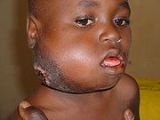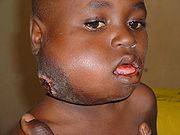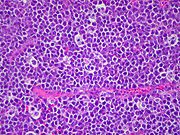
Burkitt's lymphoma
Encyclopedia


Cancer
Cancer , known medically as a malignant neoplasm, is a large group of different diseases, all involving unregulated cell growth. In cancer, cells divide and grow uncontrollably, forming malignant tumors, and invade nearby parts of the body. The cancer may also spread to more distant parts of the...
of the lymphatic system
Lymphatic system
The lymphoid system is the part of the immune system comprising a network of conduits called lymphatic vessels that carry a clear fluid called lymph unidirectionally toward the heart. Lymphoid tissue is found in many organs, particularly the lymph nodes, and in the lymphoid follicles associated...
(in particular, B lymphocytes). It is named after Denis Parsons Burkitt
Denis Parsons Burkitt
Denis Parsons Burkitt , surgeon, was born in Enniskillen, County Fermanagh, Ireland. He was the son of James Parsons Burkitt. Aged eleven he lost his right eye in an accident. He attended Portora Royal School in Enniskillen and Dean Close School, England...
, a surgeon
Surgeon
In medicine, a surgeon is a specialist in surgery. Surgery is a broad category of invasive medical treatment that involves the cutting of a body, whether human or animal, for a specific reason such as the removal of diseased tissue or to repair a tear or breakage...
who first described the disease in 1956 while working in equatorial Africa
Equatorial Africa
Equatorial Africa is an ambiguous term that is sometimes used to refer to tropical Africa, or the region of Sub-Saharan Africa traversed by the equator....
.
Classification
Currently Burkitt's lymphoma can be divided into three main clinical variants: the endemic, the sporadic and the immunodeficiency-associated variants. Burkitt's lymphoma is usually associated with over 90% of AIDS cases.- The endemic variant occurs in equatorial AfricaEquatorial AfricaEquatorial Africa is an ambiguous term that is sometimes used to refer to tropical Africa, or the region of Sub-Saharan Africa traversed by the equator....
. It is the most common malignancy of children in this area. Children affected with the disease often also had chronic malariaMalariaMalaria is a mosquito-borne infectious disease of humans and other animals caused by eukaryotic protists of the genus Plasmodium. The disease results from the multiplication of Plasmodium parasites within red blood cells, causing symptoms that typically include fever and headache, in severe cases...
, which is believed to have reduced resistance to Epstein-Barr virusEpstein-Barr virusThe Epstein–Barr virus , also called human herpesvirus 4 , is a virus of the herpes family and is one of the most common viruses in humans. It is best known as the cause of infectious mononucleosis...
(EBV), allowing it to take hold. The disease characteristically involves the jaw or other facial bone, distal ileum, cecum, ovaries, kidney or the breast.
- The sporadic type of Burkitt lymphoma (also known as "non-African") is another form of non-Hodgkin lymphomaNon-Hodgkin lymphomaThe non-Hodgkin lymphomas are a diverse group of blood cancers that include any kind of lymphoma except Hodgkin's lymphomas. Types of NHL vary significantly in their severity, from indolent to very aggressive....
found outside of Africa. The tumor cells have a similar appearance to the cancer cells of classical African or endemic Burkitt lymphoma. Again it is believed that impaired immunity provides an opening for development of the Epstein-Barr virusEpstein-Barr virusThe Epstein–Barr virus , also called human herpesvirus 4 , is a virus of the herpes family and is one of the most common viruses in humans. It is best known as the cause of infectious mononucleosis...
. Non-Hodgkin lymphoma, which includes Burkitt's, accounts for 30-50% of childhood lymphoma. The jaw is less commonly involved, compared to the endemic variant. The ileo-cecal region is the common site of involvement.
- Immunodeficiency-associated Burkitt lymphoma is usually associated with HIVHIVHuman immunodeficiency virus is a lentivirus that causes acquired immunodeficiency syndrome , a condition in humans in which progressive failure of the immune system allows life-threatening opportunistic infections and cancers to thrive...
infection or occurs in the setting of post-transplant patients who are taking immunosuppressive drugs. Burkitt lymphoma can be one of the diseases associated with the initial manifestation of AIDSAIDSAcquired immune deficiency syndrome or acquired immunodeficiency syndrome is a disease of the human immune system caused by the human immunodeficiency virus...
.
By morphology
Morphology (biology)
In biology, morphology is a branch of bioscience dealing with the study of the form and structure of organisms and their specific structural features....
(i.e. microscopic appearance) or immunophenotype, it is almost impossible to differentiate these three clinical variants. Immunodeficiency-associated Burkitt lymphoma may demonstrate more plasmacytic appearance or more pleomorphism, but these features are not specific.
Epidemiology
Of all cancers involving the same class of blood cellLymphoproliferative disorders
Lymphoproliferative disorders refer to several conditions in which lymphocytes are produced in excessive quantities. They typically occur in patients who have compromised immune systems...
, 2% of cases are Burkitt's lymphoma.
Malignant B cell characteristics
Normal B cells possess rearranged immunoglobulin heavy and light chain genes and each isolated B-cell possesses a unique IgH gene rearrangement. Since Burkitt lymphoma and other B-cell lymphomas are a clonal proliferative process, all tumor cells from one patient are supposed to possess identical IgH genes. When the DNA of tumor cells is analyzed using electrophoresisElectrophoresis
Electrophoresis, also called cataphoresis, is the motion of dispersed particles relative to a fluid under the influence of a spatially uniform electric field. This electrokinetic phenomenon was observed for the first time in 1807 by Reuss , who noticed that the application of a constant electric...
, a clonal band can be demonstrated, since identical IgH genes will move to the same position. On the contrary, when a normal or reactive lymph node is analyzed using the same technique, a smear rather than a distinct band will be seen. This technique is useful since sometimes benign reactive processes (e.g. infectious mononucleosis) and malignant lymphoma can be difficult to distinguish.
Microscopy

Immunohistochemistry
The tumor cells in Burkitt lymphoma generally strongly express markers of B cell differentiation (CD20, CD22, CD19) as well as CD10, and BCL6. The tumour cells are generally negative for BCL2 and TdT. The high mitotic activity of Burkitt lymphoma is confirmed by nearly 100% of the cells staining positive for Ki67.Genetics
Almost by definition, Burkitt's lymphoma is associated with a chromosomal translocationChromosomal translocation
In genetics, a chromosome translocation is a chromosome abnormality caused by rearrangement of parts between nonhomologous chromosomes. A gene fusion may be created when the translocation joins two otherwise separated genes, the occurrence of which is common in cancer. It is detected on...
of the c-myc gene. This gene is found at 8q24.
- The most common variant is t(8;14)(q24;q32). This involves c-myc and IGH@IGH@Immunoglobulin heavy locus, also known as IGH@, is a region on human chromosome 14 that contains a gene for the heavy chains of human antibodies .-Further reading:...
. A variant of this, a three-way translocation, t(8;14;18), has also been identified.
- A rare variant is at t(2;8)(p12;q24). This involves IGK@IGK@Immunoglobulin kappa locus, also known as IGK@, is a region on human chromosome 2 that contains genes for the kappa light chains of antibodies ....
and c-myc.
- Another rare variant is t(8;22)(q24;q11). This involves IGL@IGL@Immunoglobulin lambda locus, also known as IGL@, is a region on human chromosome 22 that contains genes for the lambda light chains of antibodies .- Function :...
and c-myc.
Treatment
Treatment includes dose-adjusted EPOCH with Rituxan (rituximabRituximab
Rituximab, sold under the trade names Rituxan and MabThera, is a chimeric monoclonal antibody against the protein CD20, which is primarily found on the surface of B cells...
).
Effect of the chemotherapy
Chemotherapy
Chemotherapy is the treatment of cancer with an antineoplastic drug or with a combination of such drugs into a standardized treatment regimen....
, as with all cancers, depends on the time of diagnosis. With faster growing cancers, such as Burkitt's, the cancer actually responds faster than with slower growing cancers. This rapid response to chemotherapy can be hazardous to patient, as a phenomenon called "tumor lysis syndrome
Tumor lysis syndrome
In medicine , tumor lysis syndrome is a group of metabolic complications that can occur after treatment of cancer, usually lymphomas and leukemias, and sometimes even without treatment...
" could occur. Close monitoring of patient and adequate hydration is essential during the process.
Chemotherapy
Chemotherapy
Chemotherapy is the treatment of cancer with an antineoplastic drug or with a combination of such drugs into a standardized treatment regimen....
- cyclophosphamideCyclophosphamideCyclophosphamide , also known as cytophosphane, is a nitrogen mustard alkylating agent, from the oxazophorines group....
- doxorubicinDoxorubicinDoxorubicin INN is a drug used in cancer chemotherapy. It is an anthracycline antibiotic, closely related to the natural product daunomycin, and like all anthracyclines, it works by intercalating DNA....
- vincristineVincristineVincristine , formally known as leurocristine, sometimes abbreviated "VCR", is a vinca alkaloid from the Catharanthus roseus , formerly Vinca rosea and hence its name. It is a mitotic inhibitor, and is used in cancer chemotherapy.-Mechanism:Tubulin is a structural protein that polymerizes to...
- methotrexateMethotrexateMethotrexate , abbreviated MTX and formerly known as amethopterin, is an antimetabolite and antifolate drug. It is used in treatment of cancer, autoimmune diseases, ectopic pregnancy, and for the induction of medical abortions. It acts by inhibiting the metabolism of folic acid. Methotrexate...
- cytarabineCytarabineCytarabine, or cytosine arabinoside, is a chemotherapy agent used mainly in the treatment of cancers of white blood cells such as acute myeloid leukemia and non-Hodgkin lymphoma. It is also known as Ara-C...
- ifosfamideIfosfamideIfosfamide is a nitrogen mustard alkylating agent used in the treatment of cancer.It is sometimes abbreviated "IFO".-Uses:It is given as a treatment for a variety of cancers, including:...
- etoposideEtoposideEtoposide phosphate is an anti-cancer agent. It is known in the laboratory as a topoisomerase poison. Etoposide is often incorrectly referred to as a topoisomerase inhibitor in order to avoid using the term "poison" in a clinical setting...
- rituximabRituximabRituximab, sold under the trade names Rituxan and MabThera, is a chimeric monoclonal antibody against the protein CD20, which is primarily found on the surface of B cells...
Other treatments are immunotherapy
Immunotherapy
Immunotherapy is a medical term defined as the "treatment of disease by inducing, enhancing, or suppressing an immune response". Immunotherapies designed to elicit or amplify an immune response are classified as activation immunotherapies. While immunotherapies that reduce or suppress are...
, bone marrow transplant
Bone marrow transplant
Hematopoietic stem cell transplantation is the transplantation of multipotent hematopoietic stem cell or blood, usually derived from bone marrow, peripheral blood stem cells, or umbilical cord blood...
s, surgery
Surgery
Surgery is an ancient medical specialty that uses operative manual and instrumental techniques on a patient to investigate and/or treat a pathological condition such as disease or injury, or to help improve bodily function or appearance.An act of performing surgery may be called a surgical...
to remove the tumor, and radiotherapy.
Prognosis
Treatment with dose-adjusted EPOCH with Rituxan (rituximabRituximab
Rituximab, sold under the trade names Rituxan and MabThera, is a chimeric monoclonal antibody against the protein CD20, which is primarily found on the surface of B cells...
) has shown an 8 year survival rate of 91% for low risk, 90% for low-intermediate risk, 67% for high-intermediate risk, and 31% for high risk cases with few of the side effects associated with Burkitt's lymphoma chemotherapy.
In adults, overall 5-year survival rate is approximately 50%.

